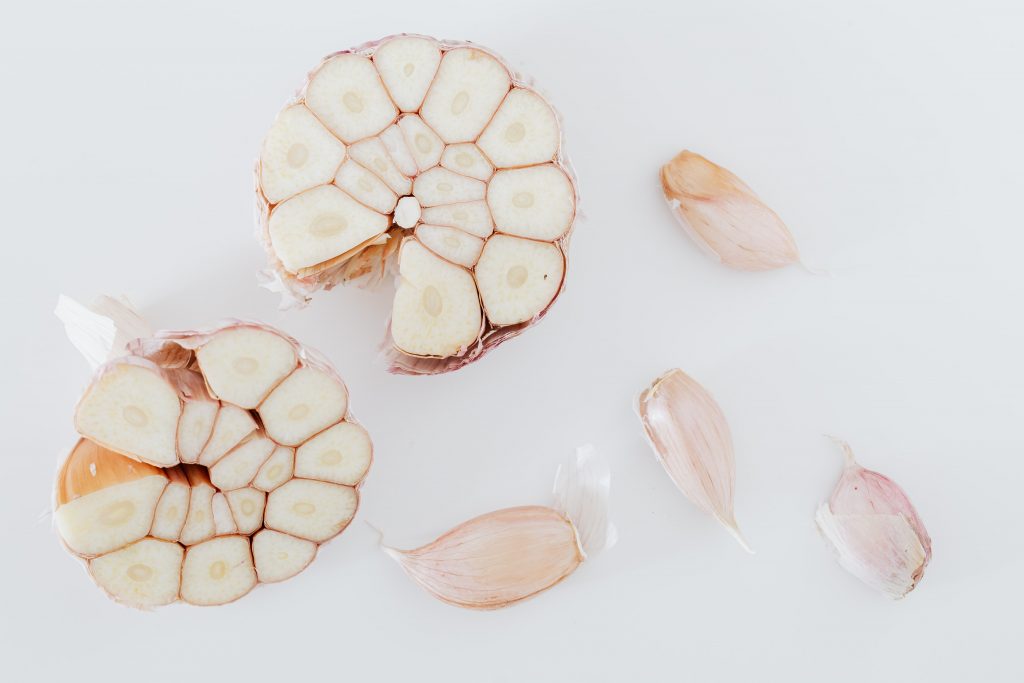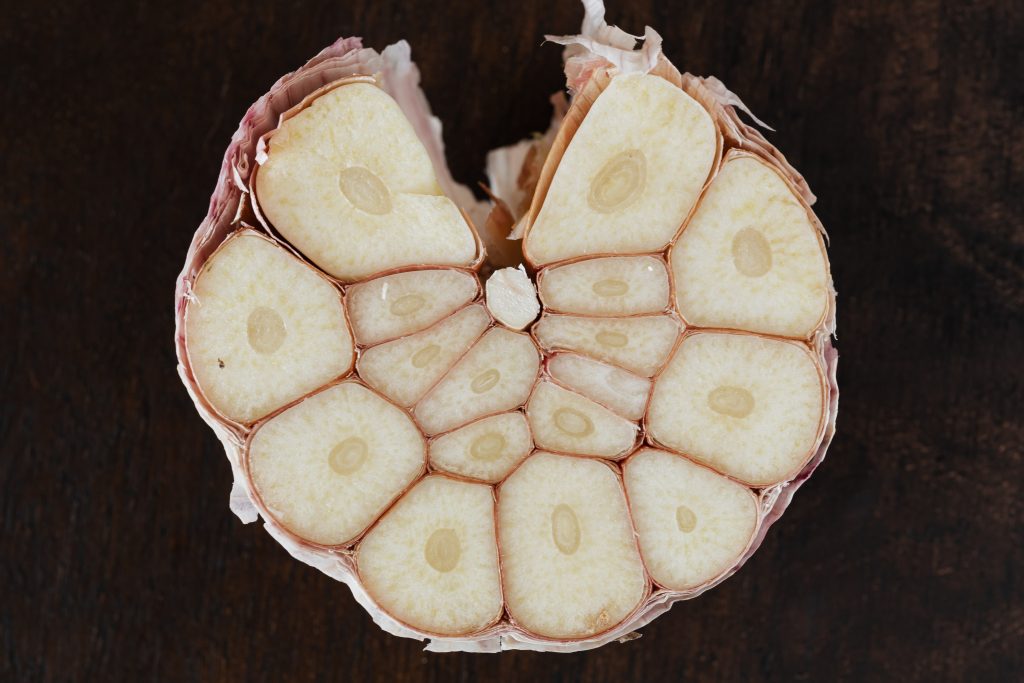It’s no secret that consuming raw foods is one of the best ways to stay healthy and fight off harmful bacteria. But did you know Garlic not only scares away vampires, but that garlic also have healing properties like; Garlic an antibiotic. Even more so, you’ll be reducing your risk of many diseases by eating more plant-based foods. This is because eating raw fruits and vegetables helps you obtain vitamins, minerals, fiber, healthy fats, and protein which support your immune system.

In this blog post, we will explore some of the most common questions about garlic as well as its potential side effects if taken in large quantities. We will also discuss how it functions as an antibiotic and an antifungal.
What is Garlic?
Garlic is a flowering plant species of the Allium genus. It is primarily used as a food ingredient, but it is also commonly used as a mulch and as a medicinal herb. Garlic is a member of the onion family and is closely related to leeks and shallots.

It has been an integral part of human culture for thousands of years, and it is still used for medicinal and food purposes today. Garlic can be grown in a variety of environments including tropical and temperate zones. It is a perennial plant that grows up to 2 feet tall, but it can be cultivated as an annual plant.
Garlic is best grown in climates with a high minimum temperature of 64 degrees Fahrenheit and a high maximum temperature of 86 degrees Fahrenheit. You can also grow it in a container so that you can harvest it when you want to.
How Does Garlic Work?
As mentioned above, garlic happens to be one of the best vegetable supplements for fighting infection and reducing the risk of illness. This is due to its potent antibiotic properties. While there are more potent antibiotics available, garlic is a more affordable and accessible treatment option.
When you consume garlic, allicin is released. Allicin is a garlic compound that has antibacterial and anti-fungal properties. When garlic is ingested, it is broken down into allicin. A variety of bacteria and fungi are killed by allicin.
Some studies have found that garlic supplementation for two months can reduce the total bacterial count by 33-50%. Moreover, it can also protect your body from various pathogens like bacteria, viruses, and parasites.
Nutritional Content of Garlic
Garlic is rich in many important nutrients such as manganese, zinc, vitamin B6, selenium, and dietary fibers. It’s great for fighting cardiovascular disease, boosting the immune system, reducing blood pressure, and reducing cholesterol levels.
Below are some key facts about garlic and its nutritional content:
- Garlic is high in sulfur, which helps improve cholesterol levels and fight cardiovascular disease.
- It is also rich in Selenium, which can help protect your body against the harmful effects of free radicals.
- It is an excellent source of vitamin B6 and manganese, which are both essential nutrients that help support the immune system.
- It contains dietary fibers that help improve digestion and reduce the risk of certain diseases like diabetes.
Benefits of Consuming Garlic
– Boosts Immunity – Consuming garlic for two months has been found to boost the immune system. This is due to the potent antibacterial and anti-fungal properties of allicin, the compound responsible for the strong odor of garlic.
– Studies have found that garlic supplements have the potential to reduce LDL (bad) cholesterol levels and increase HDL (good) cholesterol levels. It can also reduce blood pressure levels, reduce the risk of blood clotting, and prevent heart disease.
– Protects Against Infections – Studies have found that garlic supplementation has potent anti-pathogen properties that can protect you from various bacterial infections and viruses. This includes H. pylori, S. aureus, H. influenzae, and C. albicans.
How to Grow and Consume Fresh Garlic
You can grow garlic at home by purchasing a garlic plant and planting it in a pot filled with soil. You need to ensure that there is enough water present in the soil so that the garlic plant can thrive. You can also grow garlic in a container so that you can harvest the fresh bulbs whenever you want. You can consume fresh garlic in many different ways.
Some of the most common include:
– A glass of warm milk : A common method to consume raw garlic is to mix it with milk. This can help you easily consume the garlic since it is not spicy at all. You can simply drink a glass of warm milk and mix in a few tablespoons of raw garlic.
-Take Garlic in shots – Ginger, Garlic, Turmeric shots —- Lemon, Ginger, Orange, Garlic shots: These shots contain the best individual components to maintain healthy bodily functions. Read some tips on how to add juicing to your diet here.
– A raw garlic salad: you can simply mix it with a variety of fruits and vegetables such as tomatoes, cucumbers, carrots, onions, olives, and green peppers. You can also add in nuts and seeds to add more flavor and nutrition.
– Crushing the garlic and using it as a natural supplement – You can crush a raw garlic bulb and consume it as a natural supplement. Simply place the garlic bulb in a food processor and pulse a few times. Consume this as a supplement every day to receive its health benefits. You can also store the crushed garlic in a jar with a lid. This can help you easily consume garlic whenever you want to.
Should You Eat Raw Garlic?
Although consuming raw garlic is beneficial in many ways, it is not recommended to consume raw garlic for prolonged periods of time.
The allicin in garlic is extremely potent and can cause serious damage to your body if consumed in large quantities. That’s because it is potent enough to kill harmful bacteria, viruses, and fungi in the human body.

That said, consuming raw garlic for a couple of weeks is perfectly safe. It’s best to consume raw garlic in small quantities so that it doesn’t have enough time to cause damage to your body.
A raw garlic salad is a great way to consume garlic without causing any harm. A raw garlic salad can consist of a variety of fruits and vegetables such as tomatoes, cucumbers, carrots, olives, green peppers, and onions.
Is It Safe to Consume Large Amounts of Raw Garlic?
Because of its potent antibiotic and antifungal properties, raw garlic can kill harmful bacteria and fungi inside your body. That’s great news as it means that your body gets the nutrients that it needs to stay healthy.
However, long-term consumption of raw garlic has been found to damage the lining of your stomach. This is because it has the potential to cause leaky gut syndrome. That’s why it’s important to consume garlic in small amounts.
You should also avoid eating raw garlic for prolonged periods of time. That way, your stomach is protected from the damage that raw garlic could cause.
If you do decide to consume raw garlic, limit the amount you consume to two or three times per week. Also, make sure to drink plenty of water so that your stomach is adequately hydrated. This will help to prevent the damage that raw garlic could cause.
Summary
Garlic is a unique dietary supplement that can effectively treat a variety of infections and support your immune system. It can also help reduce the risk of heart disease and protect against certain infections. However, consuming raw garlic can be harmful to your body, especially if consumed in large quantities. To reap the benefits of garlic, consume it in small amounts and make sure to protect your stomach.

